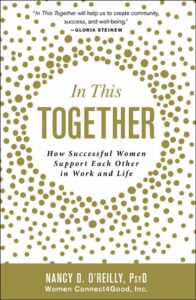 Today in the United States, the gender lens is focusing on new reasons for the continued gender pay gap, especially as women in the workplace continue to face the biggest gaps in leadership and pay, while being more educated than ever before. As we report in the new book, In This Together, the US gender wage gap is below 20 percent for women overall, although that doesn’t apply equally to women of color. In general, Latina women still have the biggest wage gap compared to white men (nearly 38 percent), then African-American women (32 percent), then white women (18 percent), and Asian women have the smallest gap (7 percent). Although companies say they realize they need to change and claim that their commitment to gender diversity is high, the gender wage gap and number of women in leadership has barely budged in decades.
Today in the United States, the gender lens is focusing on new reasons for the continued gender pay gap, especially as women in the workplace continue to face the biggest gaps in leadership and pay, while being more educated than ever before. As we report in the new book, In This Together, the US gender wage gap is below 20 percent for women overall, although that doesn’t apply equally to women of color. In general, Latina women still have the biggest wage gap compared to white men (nearly 38 percent), then African-American women (32 percent), then white women (18 percent), and Asian women have the smallest gap (7 percent). Although companies say they realize they need to change and claim that their commitment to gender diversity is high, the gender wage gap and number of women in leadership has barely budged in decades.
While we could look at the varied causes of the gap and examine things like gender bias or a lack of family-friendly policies, two articles recently came out that point to something else entirely.
The New York Times reported on mounting evidence that has led economists and sociologists to look at the wage gap in a way that has nothing to do with gender and identify a major driver – the return to working long, inflexible hours. “The return to seemingly endless work weeks has increased dramatically and is a side effect of the nation’s embrace of a winner-take-all economy. This is especially true in what social scientists call ’greedy professions’ like managerial work, law, finance and consulting. The impact of this shift is so powerful, it has canceled the effect of women’s educational gains.”
It is important to note that there is no gender gap in the financial rewards for working long hours, and for the most part, women who work an extreme schedule get paid as much as men do. But far fewer women do it, particularly mothers. Youngjoo Cha at Indiana University, Kim Weeden at Cornel find that twenty percent of fathers now work at least 50 hours a week, whereas just six percent of mothers do.
The Atlantic also looked at overwork and further reported on the recently published research by Youngjoo Cha, who finds that the pressure to work more than 50 hours a week pushes working mothers out of what we think of as male-dominated professions. Using the Census’ longitudinal Survey of Income and Program Participation, Cha found a significant correlation between male-dominated professions and their tendency to have average working hours of more than 50 hours a week.
Cha blames gender biases about work that haven’t evolved much in the last few decades. “When people are really expected to dive into the workplace and have a complete devotion to work, that was probably possible because there was someone else who can do other things for that person,” Cha says. “This overwork norm is basically built upon those assumptions.”
A recent report published by the Center for American Progress says that, “Even the most fortunate—the better-educated and better-off professionals who tend to have access to paid leave, flexibility, sick days, and decent child care—find balancing the necessary demands of work and home an increasingly fraught and anxious-making endeavor in our era of “extreme jobs” and 24/7 availability.”
The report also finds that nearly three-quarters of Americans now say that they, their neighbors, and their friends experience hardship in balancing work, family, and professional responsibilities at least somewhat often, and nearly 40 percent say that they experience such conflict “all the time” or “very often.”
This tendency towards overwork, and the status that comes with it indicates that the gap is not just about women opting out to take care of family responsibilities, this is also about a fundamental shift in the nature of work. However, simply recognizing the problem is not enough, researchers say that workers have to demand change. As it sits right now, companies are reaping the rewards of having always-on workers and won’t make the needed changes just to be kind. They have to run the risk of losing top talent if they don’t – and that includes men.
When women are the only ones who switch to jobs with predictable hours or take advantage of flexibility, it hurts their careers. We need to change the status quo and work for policies that work for women and families, not against them. Millennial men aren’t buying in to this “always-on” approach and researchers find that they want more equal partnerships, and more involvement in family life. We need to engage them, and their older counterparts, to come together and work with us for gender-neutral policies that benefit everyone equally. We can change this overwork trend and close the gap if we address the problem together.
Order Dr. Nancy’s New Book Today!
 Cultivating men as allies and working with them to achieve equality are just some of the topics covered in Dr. Nancy’s new book, In This Together: How Successful Women Support Each Other In Work and Life, along with thoughts, inspiration, and stories from 40 successful women.
Cultivating men as allies and working with them to achieve equality are just some of the topics covered in Dr. Nancy’s new book, In This Together: How Successful Women Support Each Other In Work and Life, along with thoughts, inspiration, and stories from 40 successful women.
Order your copy – and gifts for your friends today!

